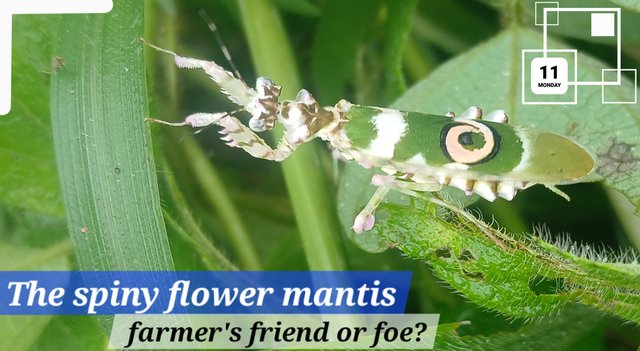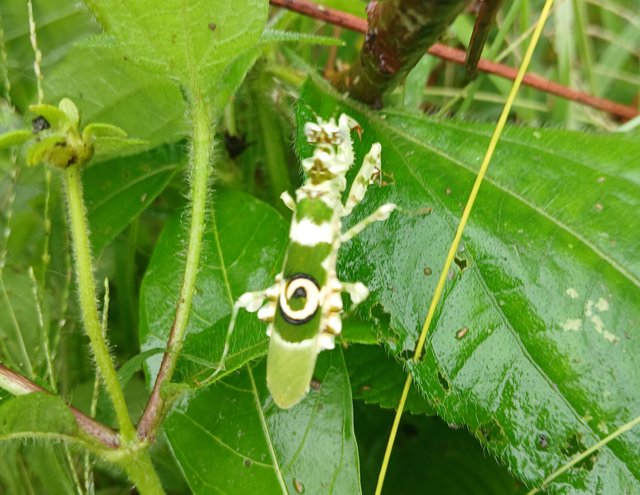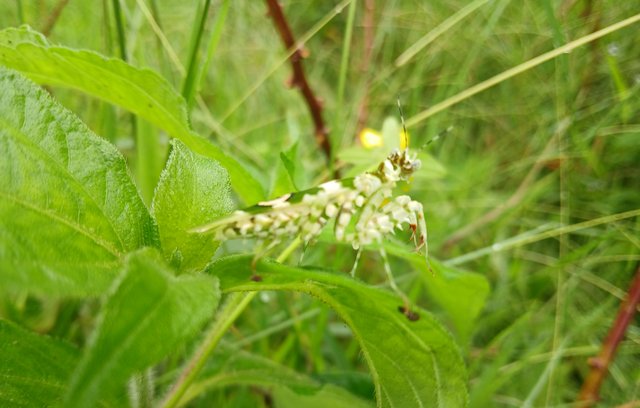Pseudocreobotra wahlbergi: Friend or Foe?
A Master of Disguise?
The Spiny Flower Mantis, is taxonomically identified as Pseudocreobotra wahlbergi, often resting motionless on a plant. When well-positioned, it realy looks more like a flower, which is the whole idea.
The camouflage strategy used by this master of disguise is truly fascinating. By remaining still, blending and mimicking a flower, it would lures in unsuspecting insects that come to feed on nectar or pollen, the mantis is often seen quietly waiting for the perfect moment to pounce on its next meal. Any insect flying close enough gets grasped by the mantis' powerful raptorial forelegs and turns into a quick snack.
The first time I came in contact with this insect, I was drawn by the design of the false eye it had on its wings. This apex predator recognises the fact that it could also be hunted by other predators higher up in the food chain, so the ocelli is there to confuse its potential predator with a false face such that the potential predator finds it hard to establish its true area of vulnerability. If a predator is actually fooled into thinking that it is the mantis's head, once it goes for it, the mantis has a good fighting chance. The design also disrupts the nature of the matis, adding more layers to its camouflage.
Feeding and Diet
The Spiny flower mantis is a fully carnivorous insect with spiked forelegs for grasping its prey and powerful mandibles for shredding and chewing.
In its daily menu, we have a variety of small insects, including Houseflies, blowflies, honeybees, solitary bees, some butterfly species, especially those that visit flowers, aphids, beetles, and other small insects that visit flowers.
Relationship with Farmers
If the Spiny Flower Mantis's diet consists of caterpillars, termites, locusts, and other pests, it would have consolidated its place as useful to the farmer. But judging from its diet of flying insects, mostly those insects that are agents of pollination, bees, butterflies, etc. The Spiny Flower Mantis is an enemy of the Farmer's friends, and the enemy of your friend can not make a good friend.
Below is a video I made of a Spiny Flower Mantis. I found it while working on the farm. They are typically still and waiting for insects who are attracted by its looks to come closer.
Have you ever seen this mantis? Will you trust it enough to have it as a pet? What do you think, how did it learn how to ambush its prey so perfectly?
You are invited to have your say in the comment section below and I am sending special invitations to @alexanderpeace, @ninapenda, and @josepha
Media Credit |
|---|
| Composer | @manuelhooks |
|---|---|
| Photographer | @manuelhooks |
| Captured with | GalaxyA15 |
| Captured Date | 8 August |
| Edited with | Canva and InShot |
| Posting Date | Mon. 11 August |
| (@) 2025 |
#steemvideo #steemexclusive #nature
#club5050 #nigeria #agriculture
#animals #camouflage
#mantis



https://x.com/manuelhook41759/status/1954983993708876256
The Pseudocreobotra wahlbergi, also known as the spiny flower mantis, is both captivating and complex. While it helps control insect pests, its predatory nature can impact beneficial species too. Its beauty disguises a skilled hunter, making it a fascinating creature that blurs the line between friend and foe in nature’s balance.